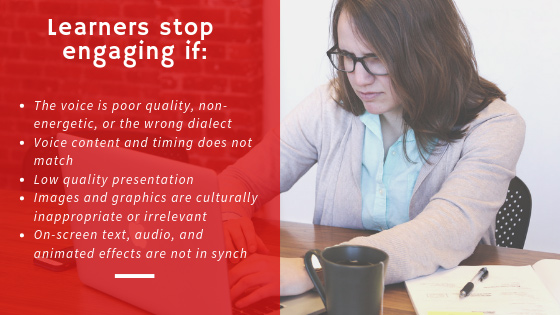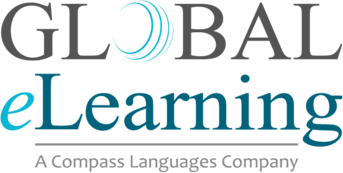Multimedia Localization
Multimedia Localization: Video Voice-overs, Subtitles & eLearning Modules
Even with excellence in transcription, translation, and voice talent, a localized eLearning Module must be engineered correctly so that the timing of audio and visual components within each slide or within a video – including special effects – is in sync with the new language components.
Global eLearning offers multimedia localization for nationwide learning. Multimedia localization is defined as the process of modifying audio, video, and other media to adapt to the needs and preferences of people found in various locations throughout the world. A key component of multimedia localization is translation, but the process goes well beyond this. The service combines translation and technical skills to produce high-quality media reflecting the source material and the target audience. This combination is valuable because it considers additional aspects, such as local regulations and cultural differences. Media that has undergone this process works as a powerful communication tool for informational or commercial purposes.

eLearning Module Translation Services
Global eLearning translates countless elearning modules to make information accessible to a wide array of audiences across cultural divides and geographic locations. We specialize in producing localized media for multilingual purposes, including training videos and other valuable resources for sales staff and other employees. With multimedia translation, audiences around the world can gain essential skills and insight into corporate and industry information and applications. Our company can perform multimedia localization on elearning modules created using software like Adobe Flash, Adobe Presenter, Adobe Captivate, Powerpoint, Lectura, and Articulate. We offer efficient translation for your multimedia content, whether you need our help from scratch or with a specific part of your module that needs our services, like subtitles or voiceovers.

What Does Multimedia Localization Entail?
User experience is the key focus of multimedia, no matter what its intended purpose might be. Anything in a video or elearning module that is part of the user experience must be localized when transitioning the media from one language to another. Everything a user hears or sees is part of the experience, including subtitles, audio, documents, and text or images on the screen. For documents, you want any linked files to be localized so that they fit your target user’s language. Global eLearning carefully and meticulously processes modules to suit a target user’s cultural, geographic, and linguistic requirements. This process incorporates a wide array of elements in the media to produce a user experience in any language that lives up to the experience of the module’s original language. Many project types need localization to make them accessible to global audiences, such as flash-based presentations, product or training materials, marketing, sales corporate videos, and instructional videos. Multimedia localization services entail all the following elements:
- Voiceovers
- Subtitling
- Script Translation
- Transcription of Original Audio
- Dubbing, Including Lip Synchronization
- Localization Engineering
- Audio and Video Production
- Animation Production
Things to Consider Before Multimedia Localization
Many businesses use multimedia localization to convert customers or educate employees in their target markets. However, the localization process is complicated and includes more steps than any other translation service. Before you undergo multimedia translation or localization to make your content accessible to a target audience, there are many things to consider. Global eLearning has listed several important factors to keep in mind prior to the process:
When Localization Actually Means Replacement
In a few situations, proper localization actually requires a full replacement of a phrase, an image, or a video instead of attempting any adaptation of the source content to accomplish localization into target culture. A photo of a police officer waving a gun within a crowd of demonstrators is inappropriate, and can be offensive, in many cultures. The image could be adapted through photoshopping, but law and order can be communicated better with a complete replacement photo.
There are no simple rules on this. It is the role of a native speaker or in-country specialist to determine if a phrase (or idiom) can be translated appropriately or should be fully replaced with another piece that generates the same thought, emotion, or impact. Jokes, riddles, and other forms of humor are sometimes best replaced instead of risking embarrassment with an inappropriate translation or adapted graphic. In general, be sure to have a native speaker in your target language/culture review all images, text, and videos to “sign-off” on the appropriateness in the new language.
Prioritizing Terminology Management Is a Must
Be sure to include term base technology at the forefront of your localization best practices list. Managing terminology is the foundation of your target languages’ consistent communication and comprehension. Make time to get your terminology straight before starting the highly complex localization process. For instance, you need to be aware of which brand names must remain in English and determine key terms related to your products and services and how to use them in each language. After making your list of brands, technical terms, and product-related terms, have in-market reviewers approve them. As a leading localization company, Global eLearning can help you organize these terms.
You Need Bulletproof Script & Subtitle Translations
Translating the script or subtitles is the first step in video localization. Every sentence in your script needs a stamp of approval from an in-market reviewer or native speaker. This step is so important because you would have to spend significant time and money altering the script later. During this step, you can make changes according to time constraints or cultural norms. You can also note tone objectives and emotional underpinnings from the original video, which translators can infuse in the process
Voiceover Management Is Crucial to the Process
Poor voiceover management has ruined many localization projects. You can avoid this situation by starting early with an experienced vendor planning ahead to make the process smoother. Do not base your strategy on one or two outstanding voiceover actors. Instead, a pool of talent at your disposal ensures you can complete your localization project timelier and avoid delays. Audio engineers will clean up and equalize the sound at this stage, but make sure you are ready to QA and evaluate the tracks and how they fit with the video.
Engineering Takes More Time Than You Think
Multimedia localization is such an expensive and time-consuming process because it relies heavily on engineers. They spend countless hours syncing tracks to video, implementing subtitles and on-screen translations, and troubleshooting your timing and layouts. You need fantastic engineers or a good vendor to handle all the heavy lifting. Some tasks like screen captures can be much trickier than you would think.
Native-Speaking Viewers Can Save Your Project
A few errors are likely to emerge in your completed project, even with incredible voice actors, translators, and engineers handling your content. One of the surest ways to save your content from being subpar is having highly capable in-market reviewers or native-speaking viewers. Give them enough time to approve every piece of content carefully. Make sure you leave time to perform QA before publishing and distributing your media as well.
A Good Localization Partner Makes Everything Easier
The multimedia localization process can include up to 10 steps for every piece of content, so having a highly qualified partner is invaluable to your content quality and a timely process. Make sure to clarify which steps of the process your localization partner will handle, such as voice talent, video editing, and LSP. With full-scale localization, you get a partner’s ample experience in all categories and access to the industry’s most advanced content localization management technology.
Trust Global eLearning With Your Content Localization
If your business needs learning modules translated or any type of localization to make your content accessible to target audiences, Global eLearning has you covered. We specialize in making the multimedia localization process as efficient and effective as possible. Contact us today to start your project with our experience and resources working to your benefit.

“This is has been the best translation work we have seen. Our Executives wanted to see the work you did because of the reputation you have here and they were blown away. Not to mention, you were half the price of your competitors; our conversation with you is what set you apart from the competition.” — Tim, Director, ENSCO
